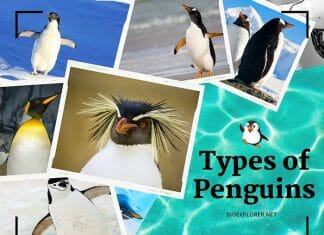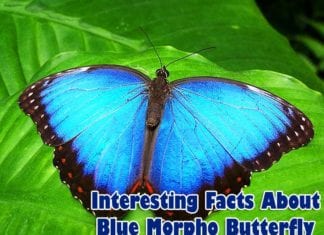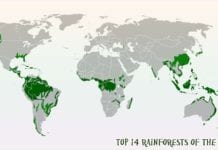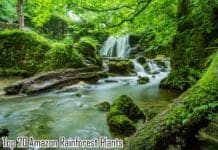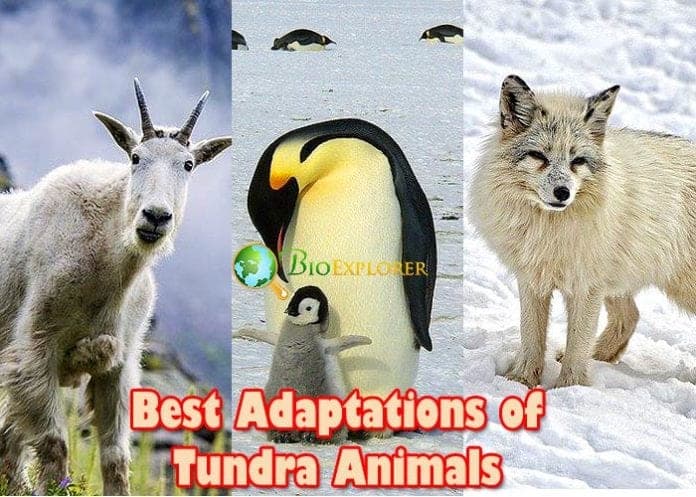
Tundra Animal Adaptations: The coldest areas on Earth, such as regions close to the North Pole and the South Pole, have unique features. Those are the areas where the temperatures are extremely low for most of the year, the sunlight is also scarce, and the soil is hardened due to permafrost.
In this article, we had explored top 18 best animal adaptations in the tundra. Read on.
Table of Contents
Types of Tundras
This leads to specific changes in the landscape:
- There are virtually no trees, as water scarcity and hardness of soil is not suitable for them.
- The vegetation is not widespread and consists mostly of low grasses, lichens, and mosses.
- If there are trees, they tend to grow very close to the ground.
As a result, we see almost a desert – landscape with rare patches of grass, mosses, and low-growing shrubs. These areas are called tundra. There are three types of tundras:
- Arctic tundra – located in the areas close to the North Pole.
- Antarctic tundra – South Pole.
- Alpine tundra – the areas located at high mountain altitudes.
Each type of tundra has its own number of challenges for the animals that choosing it as their home.
![]()
Arctic Tundra Animal Adaptations
The landscape that was described above is most typical for Arctic tundra. Siberia, Alaska, northern regions of Scandinavian countries all have tundra of this type.
- The danger of this region is not limited to extreme cold. It is also quite windy and dry there.
- Small insect and relatively small animals reign there.
- Arctic tundra inhabitants’ main features are thick fur, masquerading colors, and several adaptations that help them keep warm and effectively travel along with the snow.
Out of all Arctic tundra animals, we have chosen a few of interesting animals with unique adaptations below.
![]()
Arctic bumblebee: Fly, fly, and keep warm!
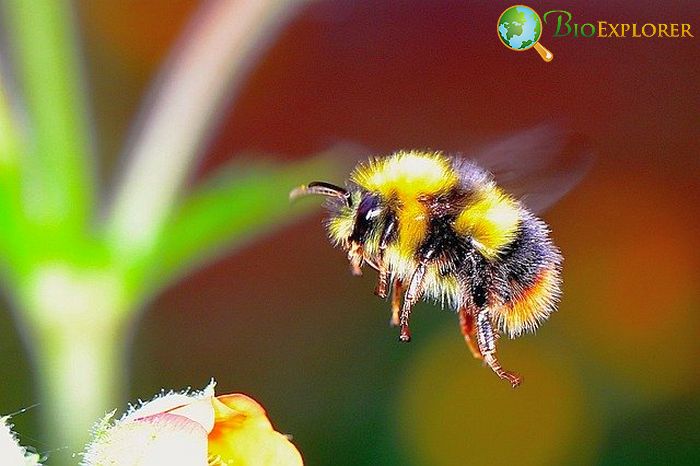
Arctic bumblebees are uniquely adapted insects that can endure freezing temperatures despite not being warm-blooded.
| Animalia | Hymenoptera | Apidae | Bombus | Bombus polaris |
- These insects have typical “bee” black-and-yellow striped coloring and are covered with multiple thin hairs.
- They can maintain their inner temperature up to around 37°C even when the surrounding environment can be as cold as 0°C.
- These buzzing striped insects can do that by performing multiple short contractions of their flight muscles always generating heat in this way.
- Arctic bumblebees also tend to fly closer to the ground, as the air there is warmer.
- Various bumblebees also adjust their development and their behavior that give them higher chances to survive colder times of the year and still create the future bumblebee generation.
Currently, the coping strategies of bumblebees are of great interest for scientists.
![]()
Norwegian lemming: I am small, bright, and angry!
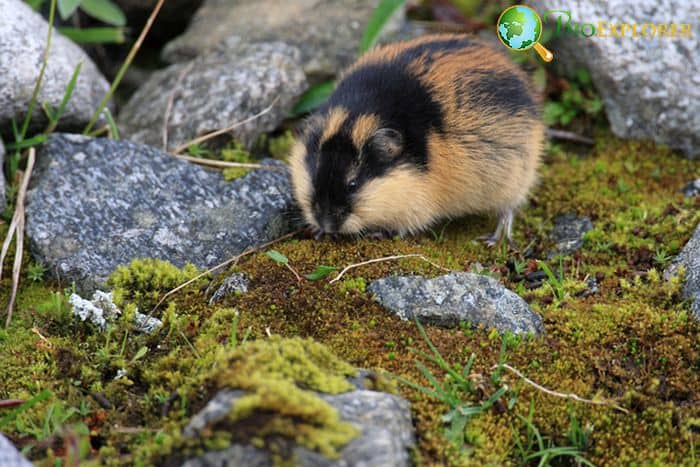
The Norwegian lemming is a small rodent that can be found in northern areas of Sweden and Norway and the Russian Federation’s Kola peninsula.
| Animalia | Rodentia | Cricetidae | Lemmus | Lemmus lemmus |
- This animal can grow up to 17 cm in size. Its body is round, with no tail, covered with thick fur.
- Unlike other species of lemmings, Norwegian lemming has exceptionally bright coloring: the back is noticeably reddish brown, the flanks yellow, and the chest white.
- Lemmings have prominent front teeth typical for rodents. The legs of the lemming are tucked under the body.
- Each paw has a large flat claw on one digit to help with digging.
- Norwegian lemmings are good diggers. They build burrows and tunnels in the soil and snow to hide away from the cold and sleep.
- Norwegian Lemmings feed primarily on mosses and lichens, which are the plants that can be found in unstable environments, where snows can melt and return irregularly.
- Lemmings have multiple predators, mainly Arctic foxes and snowy owls.
- Norwegian lemming is unique among arctic animals: instead of using masking coloring like other small rodents, these animals rely on their bright coloring and loud, aggressive barks to scare off their attackers.
![]()
Arctic fox: I am a white, predatory compact bullet!
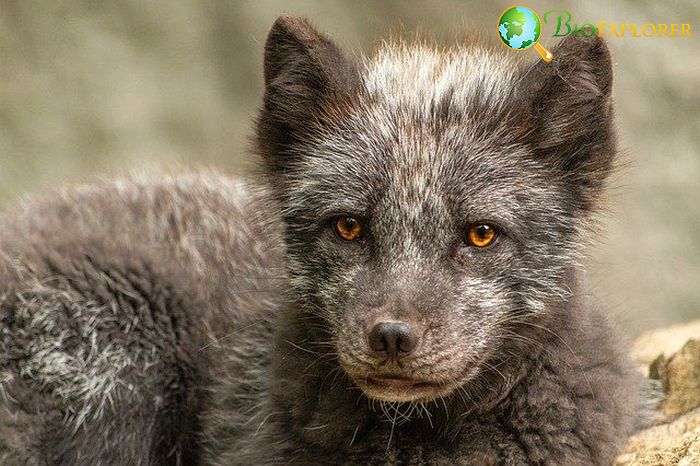
An arctic fox is one of the iconic animals of the region. It has a compact, rounded body and thick fur.
| Animalia | Carnivora | Canidae | Vulpes | Vulpes lagopus |
- The fur can be brownish blue in summer and changes to white or blue-grey in winter.
- The ears of an Arctic fox are shorter than the foxes of the warmer climates to prevent heat loss.
- The head is also more rounded, and the muzzle shorter for the same reason.
- The tail is long, thick, and fluffy. These animals are not particularly big – polar/arctic foxes can grow up to 110 cm and weigh up to 8 kg.
- Arctic foxes prefer to feed on lemmings and other small animals, eggs, and birds. Foxes can also scavenge food from polar bears.
![]()
Caribou/reindeer: Good fur is useful everywhere!
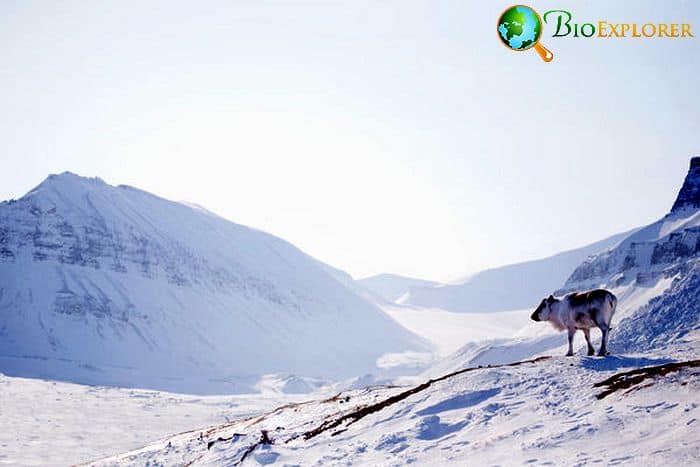
Caribou, or reindeer, have typical compact bodies, long, sturdy legs, and a typical “deer” head with small ears and prominent antlers in males.
| Animalia | Artiodactyla | Cervidae | Rangifer | Rangifer tarandus |
- Reindeer can be found in the Arctic and subarctic regions. To survive the cold, harsh climate, these majestic animals have developed specialized fur structure.
- The upper layer is composed of long, hollow hairs that lie close to the body. The lower layer is curly and short and provides additional insulation and warmth.
- The hooves’ pads are also covered with hair as the deer often feeds on underbrush and mosses that grow close to the soil under the snow. They need to continually put their muzzles in the snow in search of food.
- Therefore, their muzzles need additional protection and are also covered with insulating fur.
![]()
Alaskan Darkling Beetle: invents a novel antifreeze agent
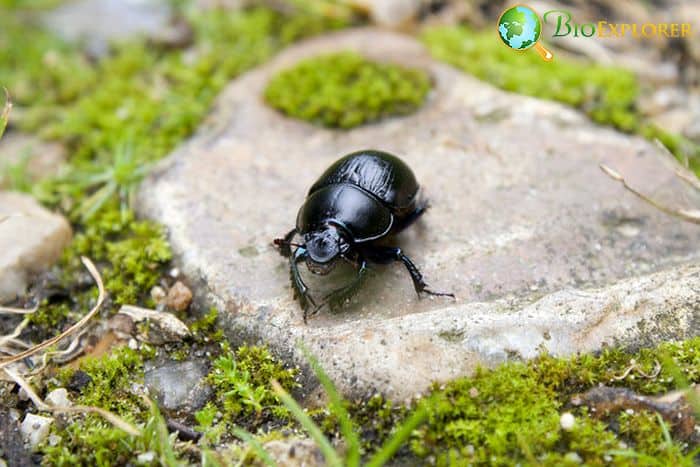
This beetle, usually called Alaska roughened darkling beetle, is often found on the dead tree logs.
- These insects have an elongated shape, and the rigid wings on its back have a typical roughened pattern with grooves.
- The insect is widespread in Alaska, northern areas of Canada, Norway, and Sweden.
- This beetle undergoes a complete metamorphosis. So, brown-colored larvae are hatching from their eggs.
- These brown caterpillar-like worms can be found in old and dead trees and are often used as mealworms.
- Both the larvae and the grown-up insects tend to feed on the trees damaged by fire.
- Their coloring that resembles the roughened tree bark makes it easier to camouflage themselves on the burnt surfaces.
- The larvae of these beetles hide under the bark of the trees, feeding mainly on fungal mycelia.
- The larvae are also good drillers and can damage wooden structures.
- Darkling beetles pose a threat to Canada’s poultry industry, as they often relocate to barns and can transmit poultry diseases.
- These beetles are known to endure very low temperatures, up to -60°C. They can do that due to having an antifreeze substance called xylomannan.
- Xylomannan is sugar. Mixes with oily substances, this sugar can attach to the cell walls and prevent the ice from entering the cells, thus surviving the cold conditions.
- These beetles can also be capable of supercooling in overly hot conditions.
![]()
Arctic Wooly Bear Moth: Mitochondria renovation to the rescue!
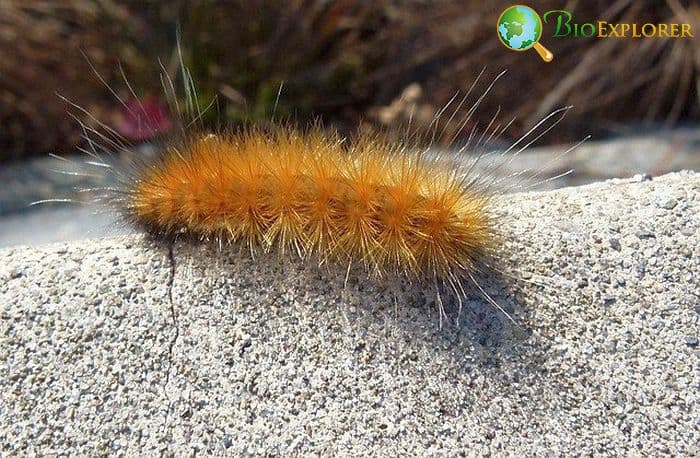
Arctic wooly bear moths live in the northernmost regions of Greenland, Canada, Alaska, and Wrangel Island of the Russian Federation.
| Animalia | Lepidoptera | Erebidae | Gynaephora | Gynaephora groenlandica |
- The moth itself has wings with typical grey-brown coloring and is rarely seen. The dominant stage of the moth’s development is its distinct larvae.
- The caterpillars of this species are short, plump, and covered with soft hair. These caterpillars feed on the Artic willow leaves.
- This species is unique because not only the larval stage is dominant in these moths, the insect can spend up to 14 years of its life as a caterpillar.
- This happens mostly because the timeframe in which the larvae can potentially feed is very short.
- Though the caterpillars can spend periods accumulating heat by staying on rocks under the sun, very often, the temperatures are too low for proper activity.
- Instead, these caterpillars tend to go into long periods of hibernation or diapause.
- They even have a unique cocoon with double walls called hibernacula to have additional protection.
Still, as the Arctic temperatures can reach as low as -60°C, even their thick hair and self-made cocoon tents are not enough.
- To survive the cold, Arctic Wooly Bears completely remodel their cells.
- They dismantle their energy factories – mitochondria – and instead of a regular energy cycle, they start producing glycerol. Glycerol is a compound that acts as an antifreeze.
- The caterpillars store a lot of glycerol in their cells. This way, no icicles form in their cells, and they can stay suspended, almost frozen for a long time.
- When it becomes warmer, the mitochondria get to rebuild, caterpillars can wake up and begin eating and growing again.
![]()
Antarctic Tundra Animal Adaptations
The Antarctic continent has a different environment compared to the Arctic.
- There is little vegetation, and the continent is covered by vast expanses of ice together with snow.
- Coastal Antarctica is both cold and too windy. The weather is rarely stable.
- The communities in the center of the continent there are predominantly composed of various small invertebrates.
- Larger wildlife lives on the coastlines and depends on marine animals for food.
- The most common species in coastal Antarctica are penguins.
![]()
Gentoo penguin: Sliding away!
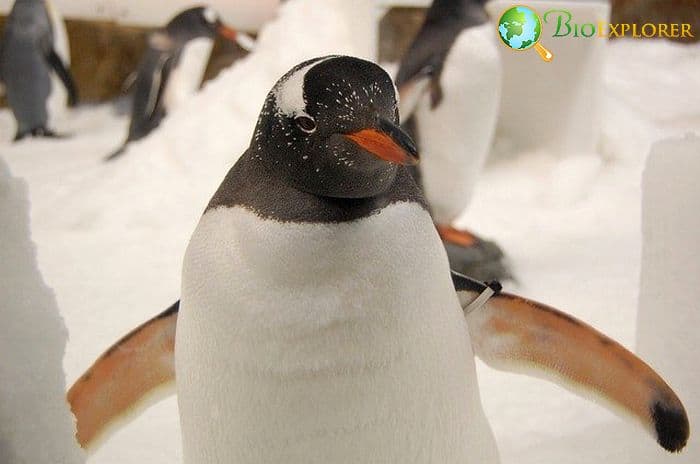
Gentoo penguins are aquatic birds found on the Antarctic continent’s shorelines, as well as some other islands in the Southern hemisphere located close to the South Pole.
Types of Penguins
- Like most of the penguins, Gentoos have white bellies and black wings and back. They can be recognized by white markings on the head and bright orange beaks.
- Gentoo penguins heavily depend on the sea for food and spend a lot of time in the water.
- While the penguins need to be close to the shore to dive for krill and fish, their nests are usually placed at an altitude to avoid being flooded.
- Gentoo penguins have a compact, bullet-like build and are excellent sliders.
- The ability to slide quickly helps them much in their life on the snow-they can easily slide down from their nests to the sea.
- Some data suggest that Gentoo penguins are even better sliders than seals.
![]()
Emperor penguin: it is all in the feathers
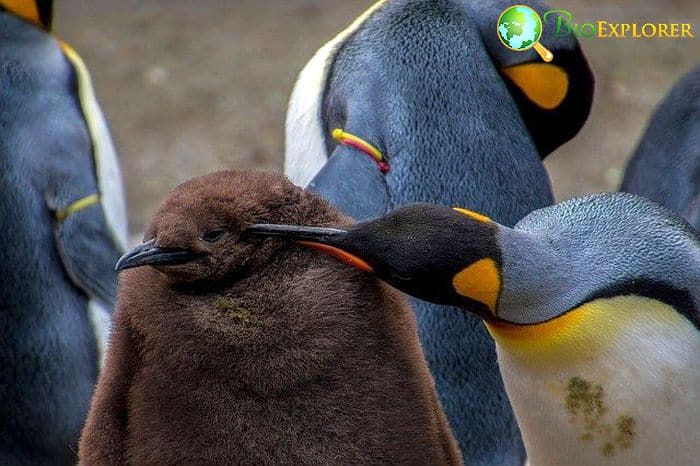
Emperor penguin is familiar to almost everyone. It is the tallest and the heaviest of all the penguin species.
| Animalia | Sphenisciformes | Spheniscidae | Aptenodytes | Aptenodytes forsteri |
- Emperor penguins live on the so-called fast ice – the areas of ice fastened to the shoreline that rarely moves. These penguins heavily depend on aquatic food.
- These birds have multiple adaptations to the cold climate they live in. One of the primary developmental “inventions” of penguins is related to their feathers.
- Penguin feathers contain high amounts of beta-keratin, contributing to the growth of multiple short, very stiff feathers.
- Besides those stiff feathers, penguins have a mix of other feather types.
- These feathers form 4 complex layers that form an impressive shield – both waterproof and insulating against the cold.
- Penguin’s feathers also can “capture” air, thus adding to the thermal isolation effect.
![]()
Antarctic leopard seal: the blubber is my secret!
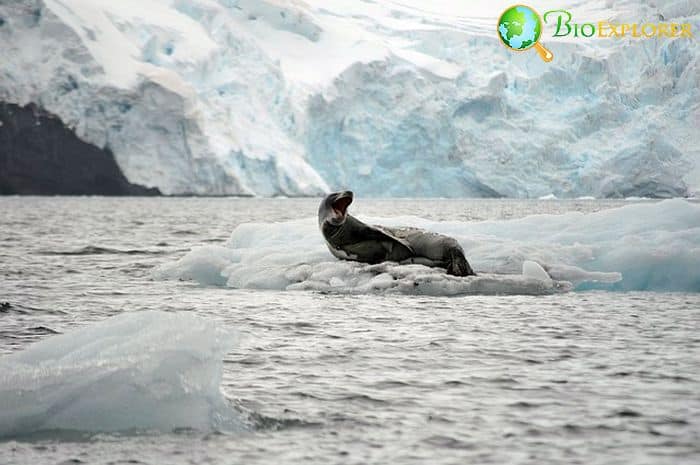
Leopard seals are quite well-known among the Antarctic seals because they pose a considerable danger to the continent’s iconic birds – penguins.
| Animalia | Carnivora | Phocidae | Hydrurga | Hydrurga leptonyx |
- This seal is a so-called true seal – it has no ears, and its flippers are relatively short.
- Leopard seals have a streamlined, cigar-shaped body with a typical “leopard” pattern. Leopard seals are fast animals and are capable of traveling long distances.
- They live on ice around the Antarctic coastline and sub – Antarctic islands.
- They are dangerous predators, consuming various animals – from large amounts of krill to smaller seals and penguins.
- The seals themselves are hunted only by killer whales and humans.
- The main component of their defense against the cold is blubber.
- The blubber is a complex structure composed of several layers of different types of fatty acids.
- Seal blubber is an extremely effective insulator. Some seals can even overheat on land on sunny days despite low temperatures.
![]()
Antarctic water bear: I am capable of suspended animation!
Water bears, moss piglets, or tardigrades are small invertebrates with unique features.
| Animalia | Parachela | Hypsibiidae | Acutuncus | Acutuncus antarcticus |
16 Immortal Animals Who Defy Death
- These animals are extremely small, up to 1.5 millimeters, have segmented, often transparent bodies with four pairs of short legs.
- They are known for their high resistance to shock, including high/low temperatures, UV light, and radiation.
- Tardigrades are aquatic animals. As continental Antarctica is a place with highly changeable weather prone to strong winds and extreme cold, tardigrades and other small invertebrates such as rotifers and nematodes are the main species area.
- The study done on one of these species, Acuntuncus antarcticus, has shown that these small animals have two unique adaptations:
- They are capable of cryptobiosis – they can temporarily stop all the activity in their bodies and remain “in limbo” for a prolonged period until the conditions become favorable.
- These species are capable of a unique method of reproduction called thelykotous parthenogenesis.
- In this process, the cells destined for reproduction can initially divide regularly, forming two cells with a single (n) number of chromosomes.
- The newly divided cells then unite together, forming a new cell with a 2n chromosome number.
- This new cell becomes an egg and develops as a regular egg should.
- Thus, a tardigrade does not require a cell from another animal of different sex to form a fertilized egg.
- Both of these strategies help tardigrades survive and reproduce in one of the harshest environments present on Earth.
![]()
Antarctic/South Polar skua
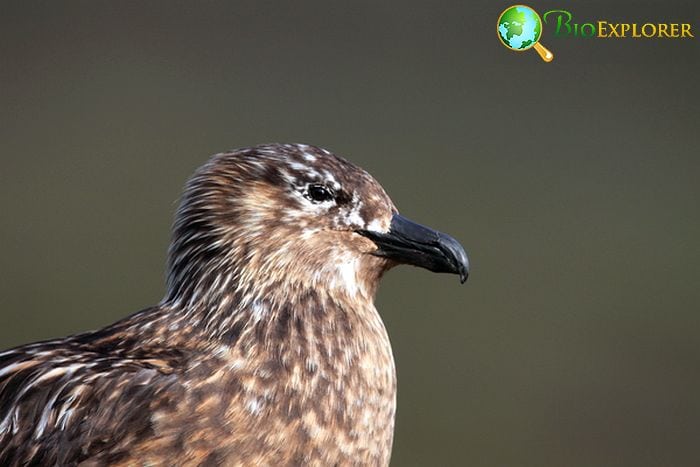
An Antarctic skua or South Polar skua is a predatory sea bird similar to a gull. It lives on the Antarctic shoreline and on the islands near the continent. It can also be seen in the Southern vicinity of New Zealand.
This bird has several variations of coloring, depending on the location:
- Honey-colored with dark wings.
- Dark chocolate brown
- Grey-brown with dark wings.
The Antarctic skua is medium-sized and has a stubby bill.
- They can be seen on shoreland, mainly during breeding. During other periods skuas spend most of their time on the sea.
- They feed on fish and debris of the sea and sometimes steal penguin chicks and eggs. Their primary survival strategy is piracy – skuas are known to attack penguins and steal their food from them.
- These birds are intelligent and have an excellent memory. They have an alarm system to warn the flock about predators. They can identify potential threats they have seen before (for example, researchers that visit often ).
- The skuas have cooperative defensive strategies -they can attack a potential threat together, dive-bombing the attacker until it runs away.
- Skuas have co-evolved with Adelie penguins, so their breeding seasons coincide. They can supplement their rations with stolen eggs or young chicks.
![]()
Alpine Tundra Animal Adaptations
The regions located at high altitudes in the mountains such as the Alps, Himalayas, Rocky Mountains, or the Appalachian Mountains have milder climates compared to Polar regions.
- The winter temperatures rarely go below -18°, and the summers could be quite hot, up to 30°C.
- Alpine regions also have a relative abundance of flora – mainly grasses and low bushes.
-
There several other challenges for the animal inhabitants of the alpine tundra to adapt to:
- High incidence of rain.
- Strong winds and blizzards.
- Permafrost (though it is less widespread in alpine tundra).
- Shorter and cooler summers.
- Prevalence of snow for long periods at higher altitudes.
- Dangerous mountain terrain.
Here are some examples of animals uniquely adapted to alpine tundra ecosystems:
![]()
Himalayan Marmot: Concentrating on the energy
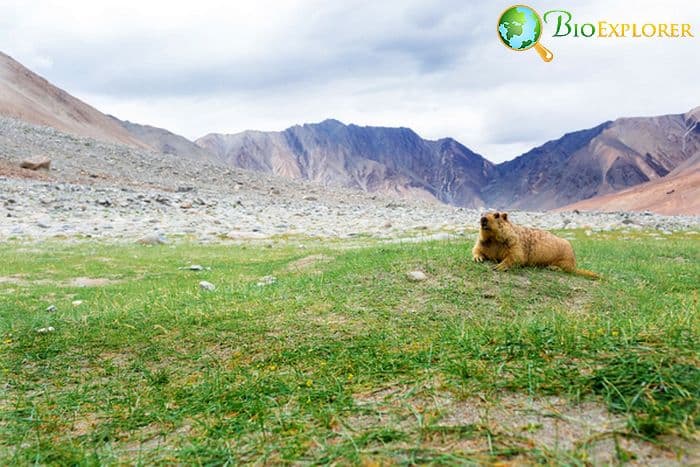
Himalayan Marmot has a mix of features between the squirrel and a groundhog.
| Animalia | Rodentia | Sciuridae | Marmota | Marmota himalayana |
- It has a large, rounded body without a tail, short, sturdy legs, a large head with prominent teeth, and well-developed claws.
- Himalayan marmots are ground diggers and build tunnels where they live and hibernate in winter.
- During winter, these animals are challenged with both hypoxia – low levels of oxygen – and cold.
- Both factors pose a danger to the animals even in the burrows they use for hibernation.
- The geneticists have found that there are certain changes in genes that help them counteract hypoxia in their genome.
- Marmots also have changes in how their stem cells form to battle the cold during the hibernation period.
- The genes involved are responsible for the regular activity of mitochondria in the cells.
- Mitochondria are responsible for providing energy, so in this way, they have constant support for their miniature energy factories.
- Other genes that have undergone changes can help protect the nerve cells of the marmot.
- In the environment with low oxygen levels, damage to the nerve cells is a constant danger.
![]()
Mountain goat: Let the hooves have some flexibility!
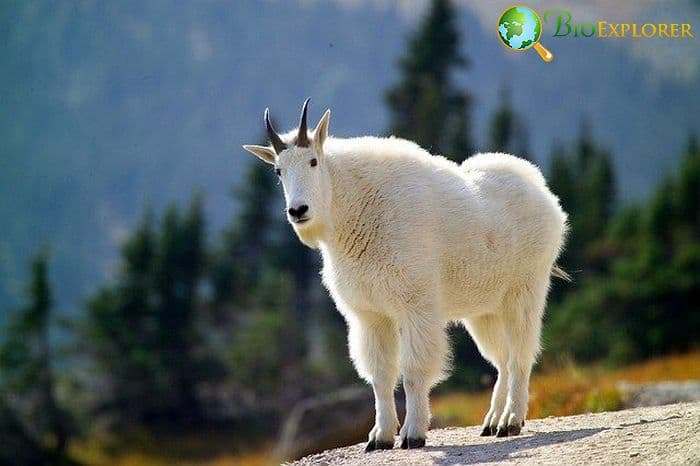
Mountain goats are elegant creatures one can meet at the mountain ranges of North America.
| Animalia | Artiodactyla | Bovidae | Oreamnos | Oreamnos americanus |
- They are sometimes called the Rocky Mountains goats.
- The name is misleading – this species is actually related to the antelopes.
- These animals have long, thick white fur, elongated head with sharp horns, and long legs.
- Their silhouette is different from goats – the fur does not lie even, forming hump-like structures on their backs.
- Their fur also forms a beard around the neck region, different from a small goatee beard of actual goats. This fur has a second underlying layer, actually.
- In the winter, the fur provides additional insulation. Simultaneously, in summer, the goats partially shed the hair, as they need to prevent overheating.
- They are adapted to living on the rocky terrain at high altitudes. They orient well on the cliffs despite their considerable weight (up to 300 pounds).
- These goats feed on grasses and low shrubs of the mountains and supplement their food with mineral salts often available at significant heights.
- These four-legged, horned creatures are long-distance jumpers, covering 12 feet in one leap.
- The need to jump often and brave snow-covered surfaces mean a considerable burden on their legs and feet.
- Therefore, their limbs have evolved, making them better adapted to the terrain.
- Their hooves have been changed. Each hoof is divided in the middle and wide, making a flat surface that can serve as a snowshoe on occasion.
- Their toe pads are also flexible, helping with jumping and enduring the impact on landing. Such anatomical innovations contribute to their climbing ability.
![]()
Snow leopard: A body made for jumping
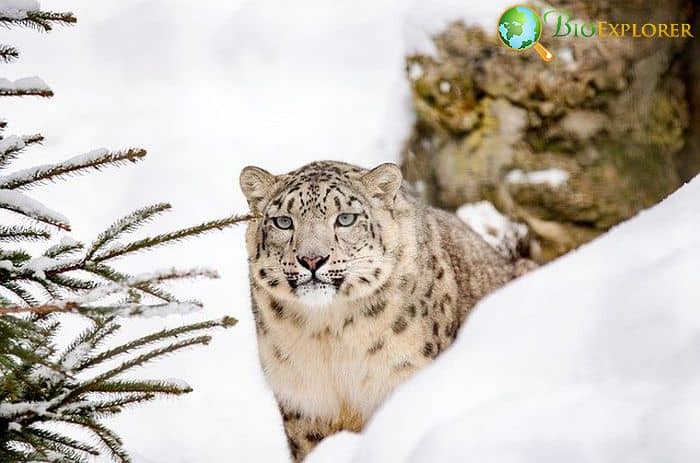
The snow leopard or irbis is the most dangerous predator in the mountains.
| Animalia | Carnivora | Felidae | Panthera | Panthera tigris |
- Snow Leopards can be found in mountain ranges of Siberia and the Himalayas. These big cats have thick fur with beautiful spotted patterns, usually black on white, gray, or creamy yellow.
- The fur of these cats is the densest and longest among all wild cat species. Similar to other mountain species, the irbis has enlarged paws that help navigate the snow.
- The snow leopards have developed some modifications to their skeleton that help them survive in their habitat:
- Their skulls are shorter, with enlarged nose openings to let more air in;
- Their limbs are organized like a cheetah – the hind legs are longer, more powerful, allowing the cat to jump and pursue the prey quickly.
- The snow leopard also has superior muscles that act as springs, helping the animal jump better
- Snow leopards have considerably longer tails that also help them balance while jumping and moving along the cliffs.
![]()
Kea parrot, New Zealand Mountain Parrot: curiosity can save me!
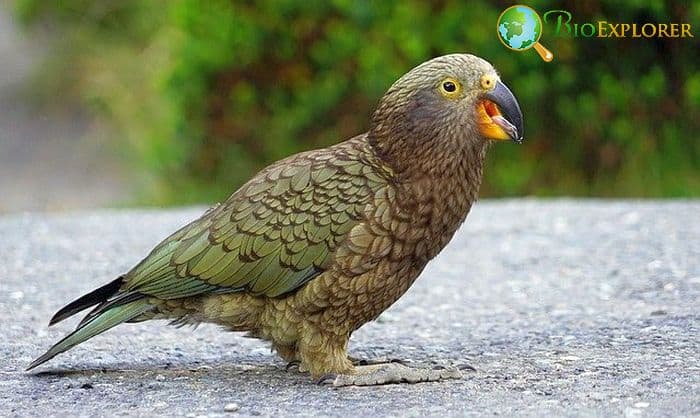
The kea parrot, a native of New Zealand, is considered the only truly alpine parrot in the world.
| Animalia | Psittaciformes | Psittacidae | Nestor | Nestor notabilis |
- Its coloring is more subdued than other parrots – the upper parts are brownish. At the same time, the lower plumage is olive green, while the underside of the wings is red.
- The kea has a long, curved beak, with the upper half considerably longer than the lower one. It is not a particularly big bird, up to 46 cm in length, and around 900 mg in weight.
- These parrots can live at high altitudes in mountain forests. They nest on the ground, not on the trees.
- The keas can feed on a variety of food – from seeds and nectar of flowers to carrion.
- One of the reasons for this bird’s endangered status was the tendency of the keas to attack sheep.
- They were heavily hunted until 1971.Keas migrate from higher to lower altitudes in winter-summer periods in search of food and for breeding.
- The major adaptation of the kea is its flexible behavior. They are very curious and interestedand are known to use tools.
- They also use their beaks to get food from under rocks and crevices.
- This way, they can manage to find food even in the most complex environments.
![]()
White-tailed ptarmigan: Devoting themselves to the snow
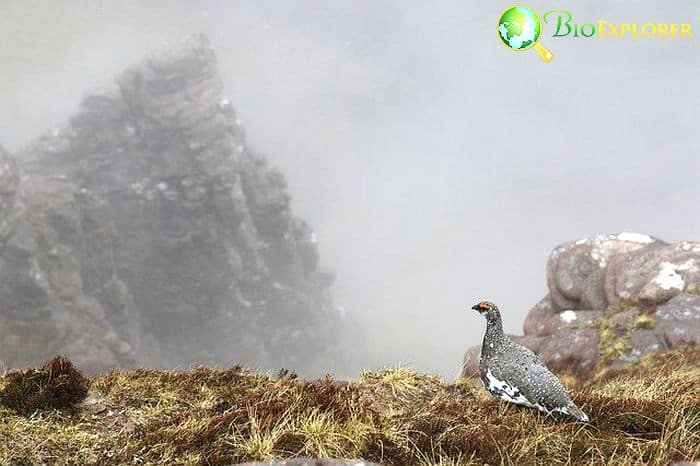
White-tailed ptarmigan is a relative of grouse that lives in northern areas of North America, including Alaska and British Columbia.
| Animalia | Galliformes | Phasianidae | Lagopus | Lagopus leucura |
- These birds are small and plump with small and sharp black beak. The main feature of the ptarmigan is that the birds literally live for the snow.
- The ptarmigan has two different “costumes” for two main seasons of the year.
- The summer plumage is grey with white stripes and a whitetail, while in winter, the ptarmigans change into purely white feathers.
- The talons of the ptarmigan are also covered with white feathers to protect them from the cold.
- In winter, the ptarmigans’ feet also grow projections called pectinations that help the birds hold on to the snow.
- The ptarmigans eat a very dry diet – mostly dry leaves and buds, which they can supplement with snow.
- They also depend on the snow to build burrows in winter to get warmer.
- Unfortunately, with global warming and snow melting, the ptarmigans’ habitat is shrinking.
- As these birds are highly adapted to cold areas in the mountains, they are becoming particularly vulnerable with less snow and warmer temperatures.
![]()
Himalayan jumping spider: I am on top of everything!
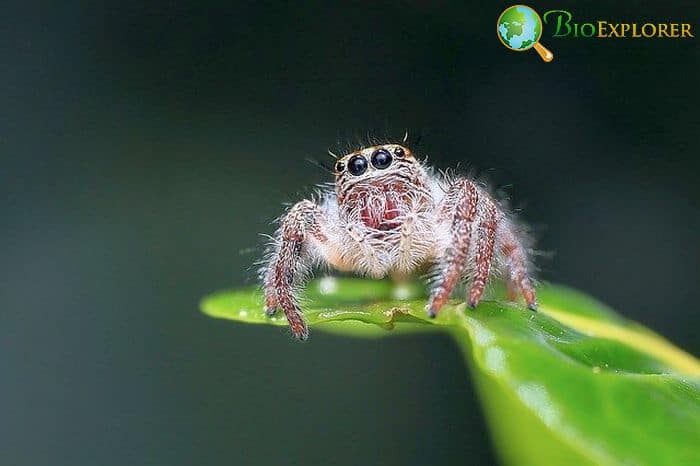
This spider belongs to the family of jumping spiders. Like other representatives of the family, this spider has eight eyes, with a body raised at the front and flattened in the back.
- The spider is small, dark brown in color, and covered with thin hair. There is a “fringe” of hair above the eyes.
- These spiders can live up to 6000 m above ground in the Himalayas, including Mount Everest.
- They are considered one of the highest living animals on Earth.
- Jumping spiders predominantly feed on springtails and other windblown insects, as other food is scarce.
The reason the Himalayan jumping spider is so successful in such harsh habitats is probably due to the combination of traits:
- Jumping spider have the best eyesight in daylight among other spider species.
- Jumping spiders have excellent hearing.
- Jumping spider has a unique mechanism for jumping – they regulate the blood pressure in their legs to propel themselves forward.
![]()
White Mountain Arctic butterfly: Live longer, eat more!
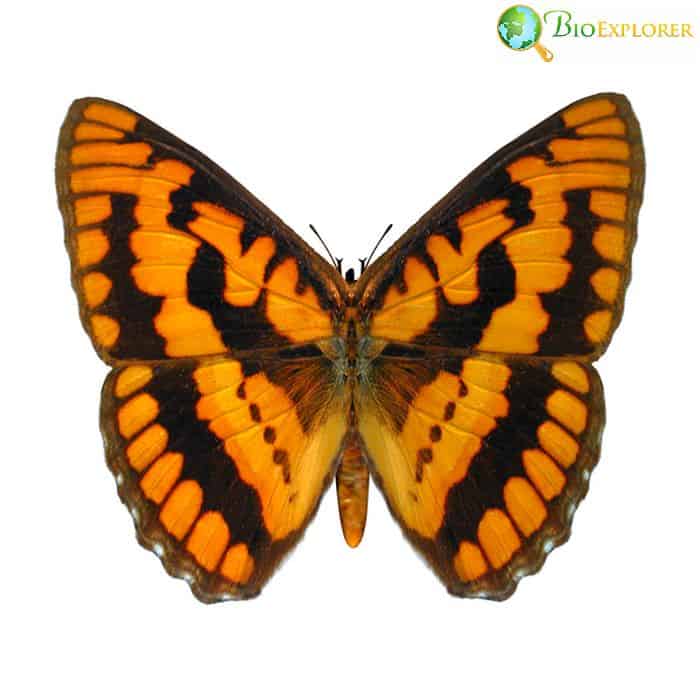
This is a butterfly species with mottled brown wings. This species can be found only in White Mountain National Forest, moreover – only on specific patches of grass on the mountains Eisenhower and Madison.
| Animalia | Lepidoptera | Nymphalidae | Oeneis | Oeneis melissa semidea |
- The butterfly prefers high, alpine regions where melting of the snow can be delayed.
- In those places, a different micro-ecosystem of plants develops that is preferable to the insect.
- The caterpillars of the species feed in various dwarf alpine plants, such as alpine bilberry, dwarf birch, and bilberry, cranberry.
- The butterflies prefer to collect nectar from sedge flowers and small wildflowers like Moss Campion.
Top 21 Facts About Blue Morpho Butterfly
These butterflies are some of the longest known butterfly species.
- As the summers high in the mountains are very short, the caterpillars cannot consume enough food in one season to become adults.
- Therefore, the caterpillars winter over and spend two summers growing, not one like other typical butterflies.
- Even in summers, the insects are forced to be “stay at home” individuals, coming out to feed only when the wind is below 40 mph and temperatures are above a particular range.
- At colder temperatures, they usually hide in rock crevices.
As this species is highly adapted to particular areas with particular temperatures, it is currently thought endangered due to climate change. The populations currently are dwindling.
![]()
As can be seen from these tundra animal adaptations, it is not enough to have white plumage and a thick layer of fat to live in the coldest areas on the planet. The animal needs to considerably change its physiology and behavior to survive in these desolate landscapes.
Most of these extremophile species are endangered due to global warming and ice melting. They are not adapted to a warmer temperature, have a hard time finding food and reproducing without the support of ice and snow, and are slowly dying out.
![]()


